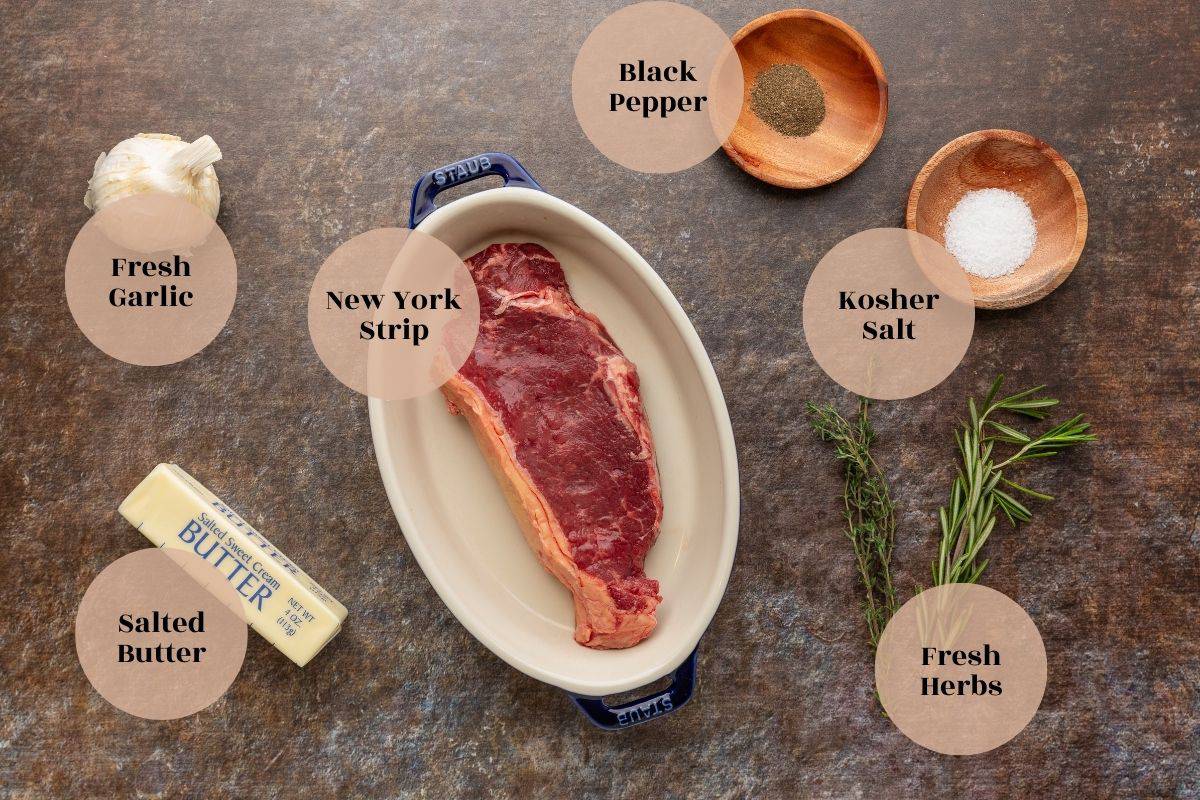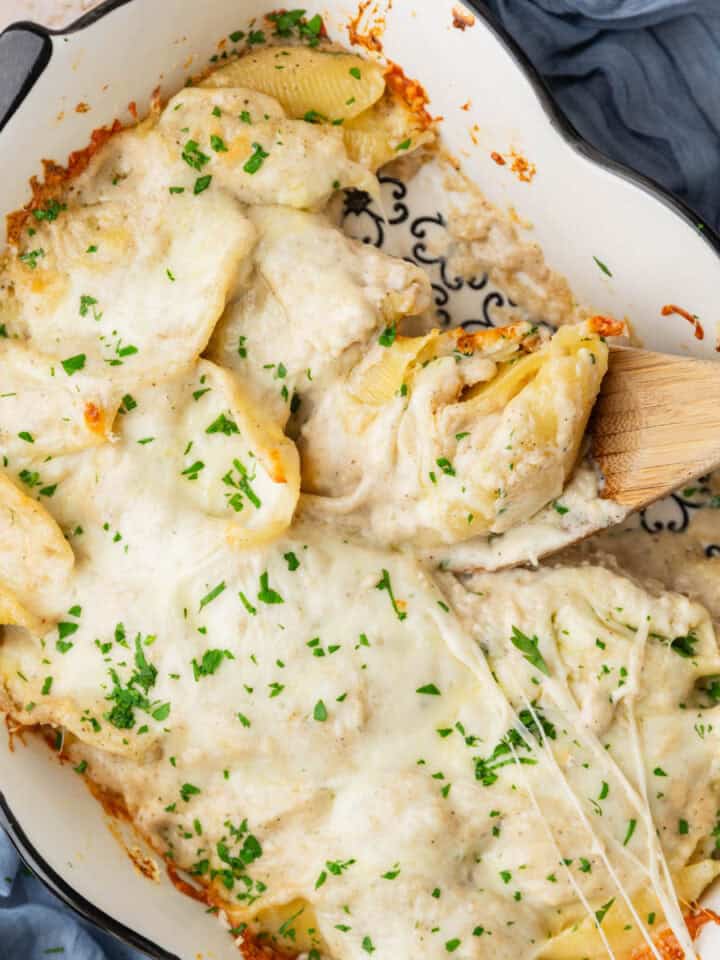
Let me show you how easy it is to cook a Juicy Cast Iron Steak with the best crust. I'll guide you through the simple process using basic ingredients and easy techniques!

My husband loves steak and requests it for special occasions like his birthday or Father's Day. Over the years, I have cooked steak in many different ways and with many different cuts. Hands down, my favorite way to cook steak is in a cast-iron skillet.
Follow these easy steps along with my best tips and tricks so you can cook the perfect steak, every single time.
Jump to:
- 🍳 Why You Should Cook Steak in a Cast Iron Skillet
- 🥩 Ingredients to Make the Best Cast Iron Steak
- ❤️ My Favorite Cast Iron Skillets
- 👩🏻🍳 How to Cook a Juicy Steak in a Cast Iron Pan
- 📘 Glossary
- ⭐ Tips for Getting the Perfect Crust on Steak
- 💭 More Frequently Asked Questions
- 🍳 More Recipes to Cook in Cast Iron
- 📱 #ScarlatiFamilyKitchen
- 📖 Recipe
- 💬 Comments
🍳 Why You Should Cook Steak in a Cast Iron Skillet
- Crust - A cast-iron skillet retains heat exceptionally well, allowing for the perfect sear on the steak, which will help you achieve the best crust.
- Cooking - Since cast iron retains heat so well, it cooks the steak evenly and to the perfect temperature!
- Flavor - The excellent sear on the steak from a cast iron skillet, makes the flavor exceptional. This also seals in the moisture, giving you a juicy, flavorful inside. Since cast iron retains heat so well, it also helps render fat easily, adding to the overall flavor of the steak.
🥩 Ingredients to Make the Best Cast Iron Steak

- Beef - This method works well with various cuts of steak. My favorites for cast iron cooking are ribeye and NY strip, as both have a good amount of fat that renders and enhances the flavor while cooking. Other options like sirloin, skirt steak, or thicker cuts of filet also yield delicious results. They are leaner cuts, so keep a close eye on them to prevent overcooking.
- Fat - Opt for butter vs. oil when basting your steak. I recommend a high-quality salted butter and suggest not skimping here. Grass-fed butter, with its lower saturated fat and higher milk fat content, gives you a richer mouthfeel, smoother texture, and creamier flavor. Quality becomes important when you only have a few ingredients and will make the flavors shine!
- Aromatics - Vegetables and herbs that add flavor and aroma to a dish are called aromatics. I like a combination of garlic and fresh herbs, but you can choose what you like best. Rosemary, thyme, oregano, bay leaf, or sage pair well with beef. You could also include onions, shallots, or chili.
- Seasoning - When seasoning meat, use 1 teaspoon of salt per pound. This strip steak was 12 ounces, so I used ¾ teaspoon kosher salt and ¼ teaspoon black pepper. Salt is important for flavor AND moisture, so don't skimp on that. Black pepper, on the other hand, can be adjusted based on preference.

❤️ My Favorite Cast Iron Skillets
The 10.25-inch skillet is my go-to in the kitchen!
Below is an affiliate link and I may be compensated (at no cost to you)
if you purchase something after clicking on the link.
👩🏻🍳 How to Cook a Juicy Steak in a Cast Iron Pan
Rest - Start by resting the steak at room temperature, for 30 minutes before cooking. After it has been at room temperature for 20 minutes, season with salt and pepper, then let it rest for the remaining 10 minutes.
Heat - Preheat the cast-iron skillet on the stovetop for 10 minutes (This can be done for the last 10 minutes the steak rests). Start it at medium-high, but if it starts smoking too much, lower the heat a bit.
Sear - Before searing, pat the steak dry with paper towels to remove any excess moisture on the outside. Place it in the hot pan and let it sit without touching it for 30 seconds. Flip it over and cook for another 30 seconds, again don't touch!

Lower the heat to medium, place the herbs and garlic on the steak, and melt the butter in the skillet. Once the butter melts, use a spoon to baste the steak with it.
Keep basting the steak as it cooks for about 3-5 minutes until it reaches your preferred level of doneness. Flip every 60 seconds during this process to reinforce the crust. (Lower the heat if the butter starts browning too much during this process.)
Once it reaches the perfect temperature (TIP! Use an instant-read thermometer (affiliate link) for this part!), let the steak rest on a cutting board for 10 minutes. This lets the juices redistribute, then you can slice and serve with the garlic herb-infused butter.
📘 Glossary
If you don't recognize a tool or skill I mentioned, you can look it up in my Glossary of Cooking Terms and Definitions for more information!
⭐ Tips for Getting the Perfect Crust on Steak
- #1 - No Cold Meat! Steak at room temperature browns WAY better than cold steak, so give it time to warm up.
- #2 - Season in Advance and Pat them Dry. Seasoning meat in advance draws out moisture, allowing it to reabsorb and infuse flavor throughout. Make sure to pat it dry afterward to remove any excess moisture, otherwise, it will steam, not sear.
- #3 - Get that Pan SUPER HOT! For that perfect "Maillard Reaction" you need a very hot pan that holds heat well—cue the trusty cast-iron skillet. This reaction occurs between amino acids and sugars at high temperatures, giving the meat its browning and rich, complex flavors.
- #4 - DON’T Touch It. Seriously. Resist the urge to poke, prod, move, squish, or disturb your steak after you put it in the pan and after the first flip. This will disrupt the formation of the crust and can lead to uneven cooking and a dry steak.
💭 More Frequently Asked Questions
While every chef has special tips and tricks, using an instant-read thermometer is the most reliable way to ensure your steak is perfectly cooked. This takes the guesswork out of cooking by giving you an accurate, real-time temperature. This is my favorite thermometer (affiliate link), which is super reliable and gives you the temperature instantly.
Start by resting the steak at room temperature and seasoning it in advance. Then, sear it to create a flavorful crust and lock in juices. Finally, baste with butter while cooking and let it rest afterward to ensure even cooking and maximum juiciness.
The first flip will happen only after the 30-second sear on the first side. Once the steak is seared on both sides, flip every 60 seconds, basting in between. This keeps the steak juicy and builds the crust. If you flip it any more frequently than that, then the steak won’t cook evenly.
No fat, butter, or oil, is needed in the skillet. A super hot and dry pan is all you need to create a Maillard reaction and form the perfect crust. Butter should only be used after the fact for basting.
🍳 More Recipes to Cook in Cast Iron
If you want more recipes to practice cooking in cast iron, here are some of my favorites (both sweet and savory)!
📖 Recipe

Juicy Cast Iron Steak with the Perfect Crust
Equipment
- 1 10-inch Cast Iron Skillet (affiliate link)
Ingredients
- 12 ounce strip steak, or ribeye
- ¾ teaspoon kosher salt, see note below
- ¼ teaspoon black pepper, see note below
- 2 whole garlic cloves, smashed
- 1 sprig fresh rosemary, or other herbs (see note below)
- 1 sprig fresh thyme, or other herbs (see note below)
- 3 Tablespoons salted butter, preferably high-quality, grass-fed
Instructions
- Remove the steak from the refrigerator 30 minutes before cooking and set it on a plate to rest at room temperature.
- For the last 10 minutes of rest time, season the steak on both sides with salt and pepper and preheat your cast iron skillet over medium-high heat on the stovetop. (Lower the heat if the pan is smoking too much)
- Pat the steak dry on both sides to remove any excess moisture on the outside, place the steak in the cast iron skillet and cook for 30 seconds without touching it. Flip it over and cook for another 30 seconds without touching it.
- Place the garlic cloves and fresh herbs on top of the steak and add the butter to the skillet to melt.
- Baste the steak with the melted butter until it is cooked to your desired internal temperature. Flip the steak every 60 seconds during cooking to help reinforce the crust. If the butter starts to brown too quickly, lower the heat. (The total time for this process will take approximately 3-5 minutes, depending on the thickness of the steak and your desired temperature - For preciseness, use an instant-read kitchen thermometer) (affiliate link).
- Let the steak rest on a cutting board for 10 minutes, then slice and serve drizzled with the garlic herb-infused butter from the pan.






Comments
No Comments